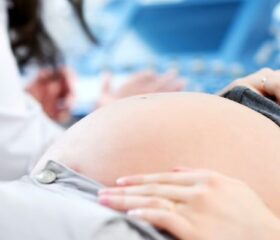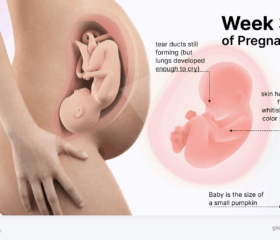Red Raspberry Leaf Tea: Can It Induce Labor and Is It Safe?
For generations, moms-to-be have sworn by certain natural remedies to ease the discomforts of pregnancy and prepare their bodies for labor. Red raspberry leaf tea is among the most popular.

If this type of herbal tea is on your radar, you’re probably wondering whether it really has any benefits during pregnancy, or if it’s even safe to consume at all.
Read on to learn what red raspberry leaf tea is, why many claim it’s a great natural remedy for pregnancy, and what science has to say about guzzling down those cups with a baby on the way.
What is red raspberry leaf tea?
Red raspberry leaf tea (RRLT) comes from the leaves of the red raspberry plant (Rubus idaeus), also known as wild red raspberry.
Unlike “normal” tea, RRLT doesn’t contain caffeine (which technically makes it a tisane or herbal infusion rather than a true tea). It contains antioxidants and nutrients like Vitamins C and E, calcium, iron, and potassium, all of which are important components in any healthy pregnancy diet. 1
RRLT has long been a favorite of herbalists and midwives for its use during pregnancy. These practitioners believe it eases certain pregnancy symptoms and acts as a safe uterine tonic that boosts muscle strength and promotes blood flow.
What does science say about the benefits of red raspberry leaf tea?
While RRLT is popular, there’s limited scientific evidence that supports many of its purported benefits. There have been relatively few studies on it, and most of the ones that have been conducted were fairly small.
Still, here are some of the supposed benefits of this herbal drink:
- Strengthening the uterus: Some believe that RRLT can strengthen the uterine muscles, although there haven’t been enough human trials to confirm this claim fully. 2
- Shortening labor: Some research found that RRLT has some capacity to reduce the duration of the second (or “pushing”) stage of labor. 3 However, the small size of the studies and inconsistent results mean most experts don’t wholeheartedly recommend it for this purpose.
- Preventing post-term birth: One observational study suggests that women drinking RRLT are less likely to go past their due date. Experts are shy about this claim due to the study’s small size and its classification as “observational,” meaning it can’t establish cause and effect. 4
- Easing pregnancy symptoms: Some women choose RRLT to take some of the sting out of pregnancy symptoms like morning sickness or cramps, but once again, there’s limited scientific backing for these claims. 5
As mentioned, the evidence for RRLT’s benefits is limited. If you’re looking for relief from some of the more uncomfortable pregnancy symptoms or want to strengthen your uterus, talk to your doctor; they’ll probably be more than happy to point you toward tried-and-tested treatments instead of alternative remedies like this.
How safe is red raspberry leaf tea during pregnancy?
Experts debate the safety of RRLT during pregnancy. Again, there’s little research on the topic, and some of it is unclear or conflicting.
As a complementary or alternative medicine, RRLT is not subject to FDA regulation, which means you need to be especially cautious with it.
Are there any side effects from red raspberry leaf tea?
There aren’t many reported adverse effects from taking RRLT during pregnancy, but to reiterate, there also haven’t been enough studies to rule out risks fully. 5
Some studies suggest that RRLT drinkers may have higher chances of needing Caesarian sections. Less alarmingly, it’s possible you’ll get looser stools and a little nausea from taking it.
Also, some claim that RRLT has a diuretic effect (in other words, that it makes you pee more often). However, this hasn’t been well-studied, and it’s unclear whether or not it’s actually true.
When can you start drinking red raspberry leaf tea during pregnancy?
If you decide that you want to try RRLT, talk to your doctor about when it’s OK to do so.
As a precaution, most experts recommend avoiding RRLT during your first trimester due to concerns about potential uterine stimulation and a risk of miscarriage. 1
Some medical professionals will give the okay for moderate RRLT consumption during your second and third trimesters, though they still might advise you to hold off until you’re around 32 weeks pregnant. 5
When you should avoid red raspberry leaf tea
Despite all the supposed benefits of RRLT, it’s not for everyone. For example, if you’ve previously had precipitous (very quick) labor (lasting 3 hours or less), you should pass on RRLT.
The same goes for women who have a scheduled C-section or a history of C-sections or premature labor.
You should also avoid RRLT if: 6
- You’ve had vaginal bleeding during the second half of your pregnancy
- You have risk factors for estrogen-sensitive conditions like ovarian cancer, endometriosis, or fibroids
- You have pregnancy complications, such as high blood pressure or preeclampsia
- You have a breech baby (your baby is in a feet-down position)
- You’re expecting multiple babies
- You’re taking antidepressants
As with any new supplement, medication, or herbal remedy, always run it past your doctor first.
Take loose red raspberry leaf tea instead of tablets or extracts
While you can get RRLT in pill form, opt for loose RRLT leaves or tea bags. This way, you’ll avoid the higher concentrations of raspberry leaf and other extra ingredients in tablets, extracts, and blended teas.
How to safely take red raspberry leaf tea
If you decide to try RRLT, here’s how to do it safely:
- Start slow: Most importantly, don’t use RRLT too early on. It’s best to postpone it until your late second or early third trimester. When you do start taking it, go slowly. Begin with a daily cup and increase your intake gradually throughout each day.
- Monitor for side effects: Once you start taking RRLT, listen to your body. If any adverse effects crop up, like frequent Braxton Hicks contractions (pre-labor “practice” contractions), diarrhea, or other discomfort, stop taking it right away. Again, starting with small amounts and gradually increasing the dose helps you pinpoint any side effects more easily.
- Stay hydrated: You need to drink plenty of water throughout your pregnancy, with most experts recommending 8–12 cups (64–96 ounces) per day as the gold standard. 7 If you’re experimenting with RRLT, remember that it may make you need to pee more often, so keep a large water bottle on hand to stay sufficiently hydrated.
Consider documenting your experience with red raspberry leaf tea in your journal or pregnancy tracker app so that you can track any changes, symptoms, or benefits over time and share accurate information with your doctor if necessary.
Final thoughts
While red raspberry leaf tea holds some potential as a natural boon for pregnant women, the science on it, unfortunately, remains inconclusive.
If you’re curious to try it, make sure you get the all-clear from your doctor first, as you should with any alternative or fringe remedy during pregnancy.
Article Sources
- American Pregnancy Association. "Herbal Tea & Pregnancy" Retrieved September 10, 2025.
- Tommy’s. "Can anything bring labour on?" Retrieved September 10, 2025.
- Journal of Midwifery & Women's Health. "Raspberry leaf in pregnancy: its safety and efficacy in labor" Retrieved September 10, 2025.
- Australian College of Midwives Incorporated Journal. "Raspberry leaf and its effect on labour: safety and efficacy" Retrieved September 10, 2025.
- Lamaze International. "So You Want to Know About... Red Raspberry Leaf Tea" Retrieved September 10, 2025.
- Tommy’s. "Can anything bring labour on?" Retrieved September 10, 2025.
- American College of Obstetricians and Gynecologists. "How much water should I drink during pregnancy?" Retrieved September 10, 2025.







